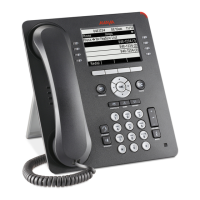VLAN settings
Issue 3 January 2014 115
Note:
Note: Regardless of the setting of L2Q, VLANTEST, or L2QVLAN, you must have
DHCP administered so that the deskphone will get a response to a
DHCPDISCOVER when it makes that request on the default (0) VLAN.
After VLANTEST expires, if a 9600 Series SIP IP deskphone receives a non-zero
L2QVLAN value, the deskphone will release the IP address and send
DHCPDISCOVER on that VLAN. Any other release will require a manual reset
before the deskphone will attempt to use a VLAN on which VLANTEST has
expired. See the Reset procedure in Chapter 3 of Installing and Maintaining
Avaya 9601/9608/9608G/9611G/9621G/9641G IP Deskphones SIP.
The deskphone ignores any VLAN ID administered on the Communication
Manager call server.
VLAN separation rules and related parameters
VLAN separation is available to control access to the voice VLAN from the secondary Ethernet
interface, and to control whether broadcast traffic from the data VLAN is forwarded to the
deskphone. The following system parameters control VLAN separation:
● VLANSEP - enables (1) or disables (0) VLAN separation.
● L2QVLAN - specifies the voice VLAN ID to be used by the deskphone.
● PHY2VLAN - specifies the VLAN ID to be used for frames forwarded to the network from
the secondary Ethernet interface.
● PHY2PRIO - the layer 2 priority value to be used for tagged frames forwarded to the
network from the secondary Ethernet interface.
VLAN separation rules provide several VLAN separation guidelines.

